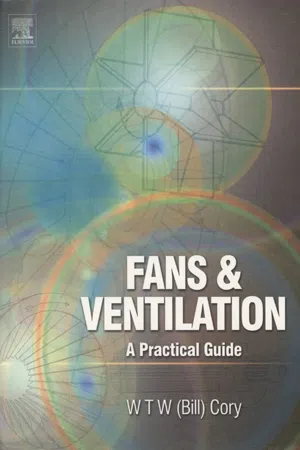
- 424 pages
- English
- ePUB (mobile friendly)
- Available on iOS & Android
About This Book
The practical reference book and guide to fans, ventilation and ancillary equipment with a comprehensive buyers' guide to worldwide manufacturers and suppliers.
Bill Cory, well-known throughout the fans and ventilation industry, has produced a comprehensive, practical reference with a broad scope: types of fans, how and why they work, ductwork, performance standards, testing, stressing, shafts and bearings.
With advances in technology, manufacturers have had to continually improve the performance and efficiency of fans and ventilation systems; as a result, improvements that once seemed impossible have been achieved. Systems now range in all sizes, shapes, and weight, to match the ever increasing applications.
An important reference in the wake of continuing harmonisation of standards throughout the European Union and the progression of National and International standards. The Handbook of Fans and Ventilation is a welcome aid to both mechanical and electrical engineers.
This book will help you to… •Understand how and why fans work •Choose the appropriate fan for the right job, helping to save time and money •Learn installation, operational and maintenance techniques to keep your fans in perfect working order •Discover special fans for your unique requirements •Source the most appropriate equipment manufacturers for your individual needs
- Helps you select, install, operate and maintain the appropriate fan for your application, to help you save time and money
- Use as a reference tool, course-book, supplier guide or as a fan/ventilation selection system
- Contains a guide to manufacturers and suppliers of ventilation systems, organised according to their different styles and basic principles of operation
Frequently asked questions
Information
Fan history, types and characteristics
1.1 Introduction
1.2 Ancient history — “Not our sort of fan”
Table of contents
- Cover image
- Title page
- Table of Contents
- Copyright
- Foreword
- Dedication
- About the author
- Using this book
- Chapter 1: Fan history, types and characteristics
- Chapter 2: The properties of gases
- Chapter 3: Air and gas flow
- Chapter 4: Fan performance Standards
- Chapter 5: Fans and ducting systems
- Chapter 6: Flow regulation
- Chapter 7: Materials and stresses
- Chapter 8: Constructional features
- Chapter 9: Fan arrangements and designation of discharge position
- Chapter 10: Fan bearings
- Chapter 11: Belt, rope and chain drives
- Chapter 12: Shaft couplings
- Chapter 13: Prime movers for fans
- Chapter 14: Fan noise
- Chapter 15: Fan vibration
- Chapter 16: Ancillary equipment
- Chapter 17: Quality assurance, inspection and performance certification
- Chapter 18: Installation, operation and maintenance
- Chapter 19: Fan economics
- Chapter 20: Fan selection
- Chapter 21: Some fan applications
- Chapter 22: Units, conversions, standards and preferred numbers
- Chapter 23: Useful fan terms translated
- Chapter 24: Guide to manufacturers and suppliers
- Chapter 25: Reference Index
- Acknowledgments
- Index to advertisers